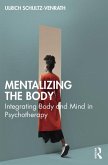Mentalizing the Body brings together theory and practice with the latest neurobiological and developmental psychological findings to understand the relevance of the body in a wide range of mental disorders, especially personality and somatization disorders.
Ulrich Schultz-Venrath provides insight on individual bodily phenomena within psychotherapeutic treatments - experienced by patients as well as therapists - and focuses on the importance of the intentionality of bodily symptoms and how they can be integrated in the talking cure. Mentalizing the Body expands the work of Anthony Bateman and Peter Fonagy, adding the "body mode" in contrast to the popular concept of "embodied mentalizing." Promoting mentalizing in psychotherapy while taking the body into account helps not only patients with somatoform and eating disorders, but also those whose psychological complaints have a missing connection to the body. Schultz-Venrath provides detailed insight on the range of therapies and treatments available, from individual and group psychotherapies to body, art, and music therapy, with clinical case studies and diagrams throughout.
Mentalizing the Body will be of great interest to practitioners and researchers - from psychoanalysts and psychotherapists to psychiatrists and psychologists seeking to understand the mentalization model, and all healthcare professionals working with severe mental disorders.
Ulrich Schultz-Venrath provides insight on individual bodily phenomena within psychotherapeutic treatments - experienced by patients as well as therapists - and focuses on the importance of the intentionality of bodily symptoms and how they can be integrated in the talking cure. Mentalizing the Body expands the work of Anthony Bateman and Peter Fonagy, adding the "body mode" in contrast to the popular concept of "embodied mentalizing." Promoting mentalizing in psychotherapy while taking the body into account helps not only patients with somatoform and eating disorders, but also those whose psychological complaints have a missing connection to the body. Schultz-Venrath provides detailed insight on the range of therapies and treatments available, from individual and group psychotherapies to body, art, and music therapy, with clinical case studies and diagrams throughout.
Mentalizing the Body will be of great interest to practitioners and researchers - from psychoanalysts and psychotherapists to psychiatrists and psychologists seeking to understand the mentalization model, and all healthcare professionals working with severe mental disorders.
"This book is about minding the body. And embodying the mind. The author leads us through the challenging field of psychosomatic disorders and beyond. His clinical and theoretical tool is the model of Mentalizing, expanded to include the body mode as the earliest pre-mentalistic mode. This is an updated psychotherapy based on the historically strong tradition of psychosomatics in Germany, and it is an event when such professional richness now becomes available in English." - Finn Skårderud, Professor of Psychiatry, University of Agder, Norway. Founder and Chair of the Norwegian Institute of Mentalizing









